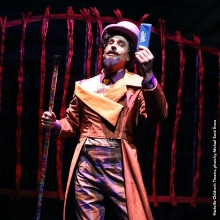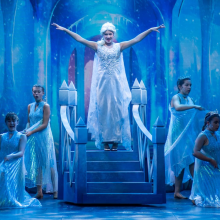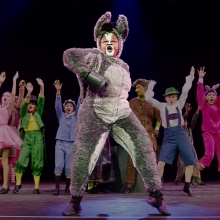Filichia Features: She Is a Pirate Queen

Filichia Features: She Is a Pirate Queen
Although I've seen between 80% and 90% of Broadway's musicals in the past 57 years, I never saw one begin with a smarter image than what the creators of The Pirate Queen dreamed up.
The curtain rose on a semi-see-through scrim. Through it we saw a ship's captain struggling through a storm, turning the steering wheel left, then right, then center before a quick turn left and an equally sharp one right.
Then the scrim was released from the rafters, fell onto the stage and the captain was revealed as a woman.
Use this startling effect when you do The Pirate Queen, written by the same team that created Miss Saigon - Claude Michel Schönberg, Alain Boublil and Richard Maltby, Jr. - with contributions by John Dempsey. (Schönberg and Boublil, of course, are even more famous for Les Miserables.)
The sung-through musical is somewhat based on Morgan Llywelyn's historical novel Grania: She-King of the Irish Seas. Grania was the nickname for Grace O'Malley, a 16th century Irish heroine worth your admiration.
She was born right around the time the Tudors took over Ireland - and in an era when sailors truly believed that taking women to sea meant bad luck. Grace was determined to sail and dressed as a man to make that happen.
You've seen hundreds of stories where women dress as men. However, if Yentl is discovered, she gets thrown out of school. If Victor is unmasked as Victoria, she loses her nightclub gig. But if Grace is found out, she walks the plank.
Here's musical theater's favorite theme: Love vs. Career. Grace loves Tiernan, but her father wants her to marry Donal, which he insists would be better for the family and better for Irish solidarity. "Choose to wed for yourself or your land," says her father.
In such stories, daughters always fight their fathers to marry the men they love -- and win. That Tiernan is said to be below Grace's station is yet another familiar element. The surprise is that Grace sees the substantially bigger picture: Ireland must be united in order to fight the British, and if this marriage can help, she'll put aside her feelings and do it.
As co-bookwriter Dempsey says, "Grace acts rather than acted upon." Co-bookwriter and co-lyricist Alain Boublil agrees: Grace "always falls back on her feet and starts all over again. She has the ability to reinvent herself and turn around a situation with bravery. She behaves like - or better than - the boldest of men, juggling a career and a complex personal life."
Frank Galati, who directed the original Broadway production, says "Her piracy was born out of need rather than greed, so she could feed her people and clothe the men and women of her class -- protect them in the same way that Elizabeth I did for her people."
Donal is less lofty - "a lout and a drunkard," says Mark Dendy, the show's original choreographer. One lyric he sings reveals a good deal: "A conjugal vow doesn't change a bull to a cow."
Dempsey admits the show is "a fictional treatment of non-fictional characters." So Donal betrays the Irish. As Boublil says, "Hopefully, it won't offend any of his descendants."
Act One shows Grace the daughter; Act Two displays two queens fighting for their countries. Elizabeth imprisons Grace. The sudden convict is fortunate that Tiernan opts to care for the child she had with the now-irrelevant Donal.
Elizabeth and Grace eventually discover that they have more in common than they might have thought. Both are strong women who have wound up as successors to their fathers. They talk of the children they might have had, too.
Grace is a great role for a fine actress, for she must convincingly age from a teen to fifty-something. Because the authors see Grace as a modern woman, her music is very much in the rock vein. However, your Elizabeth should sport a fine mezzo-soprano.
Galati says that despite its being "an epic historical romance" it can be staged as "a spectacle in a teacup" with "sprinkling cut paper for snow and shaking a piece of fabric to indicate the sea." The orchestrations require only 11 musicians, but you will need flautists who can make that distinctive Irish sound. Get those fiddlers down from the roofs, too, to fiddle away.
Moya Doherty and John McColgan of Riverdance first had the idea for the show, so it does put dance front and center. Dendy notes that one of the first numbers has "twelve strapping Irish sailors do a pounding percussive dance with their oars." More dances occur at a wedding, christening and funeral, as is the traditional Irish custom.
There's some Irish stepdancing, too. You won't have to worry what your dancers will do with their arms -- stepdancing has them just hang by one's sides - but the dancing is nevertheless akin to an aerobic workout. Even your hardiest performers may complain a bit, but they'll find they won't need to go to the gym if they do The Pirate Queen.
You may e-mail Peter at pfilichia@aol.com. Check out his weekly column each Monday at www.broadwayselect.com and Tuesday at www.masterworksbroadway.com . His book, The Great Parade: Broadway's Astonishing, Never-To-Be Forgotten 1963-1964 Season is now available at www.amazon.com.

























